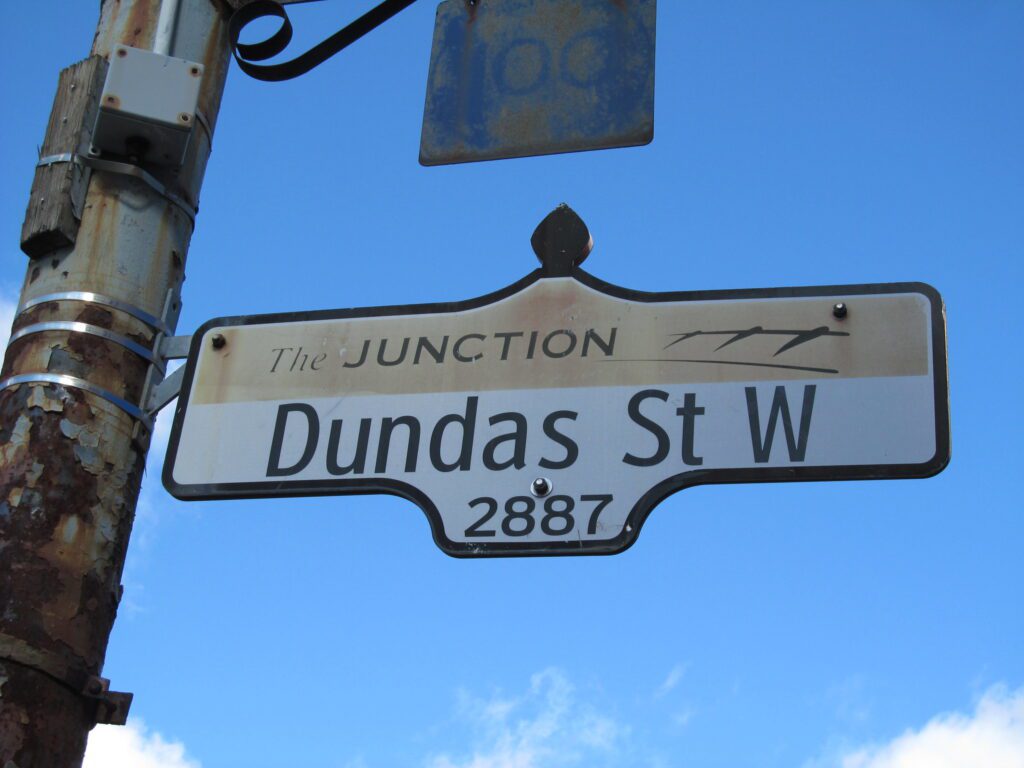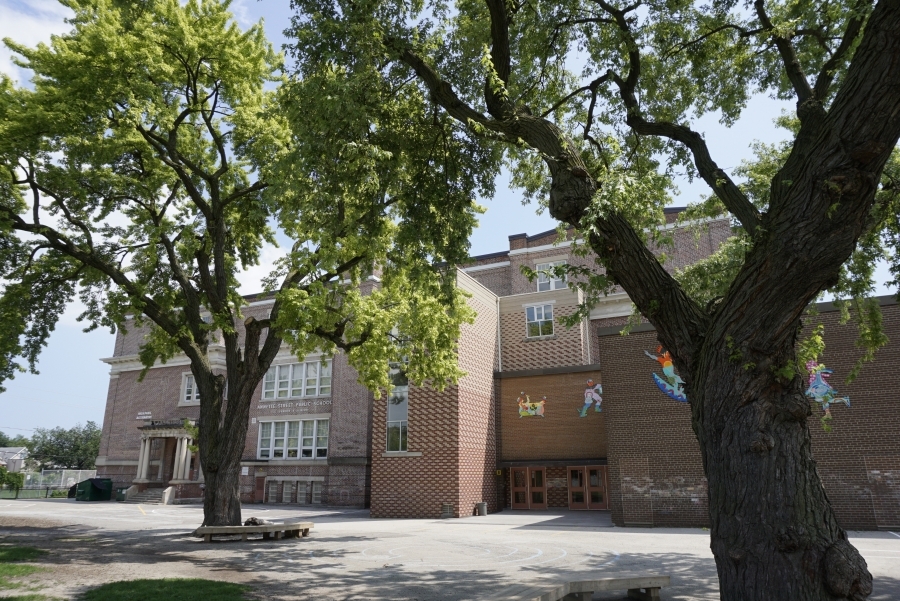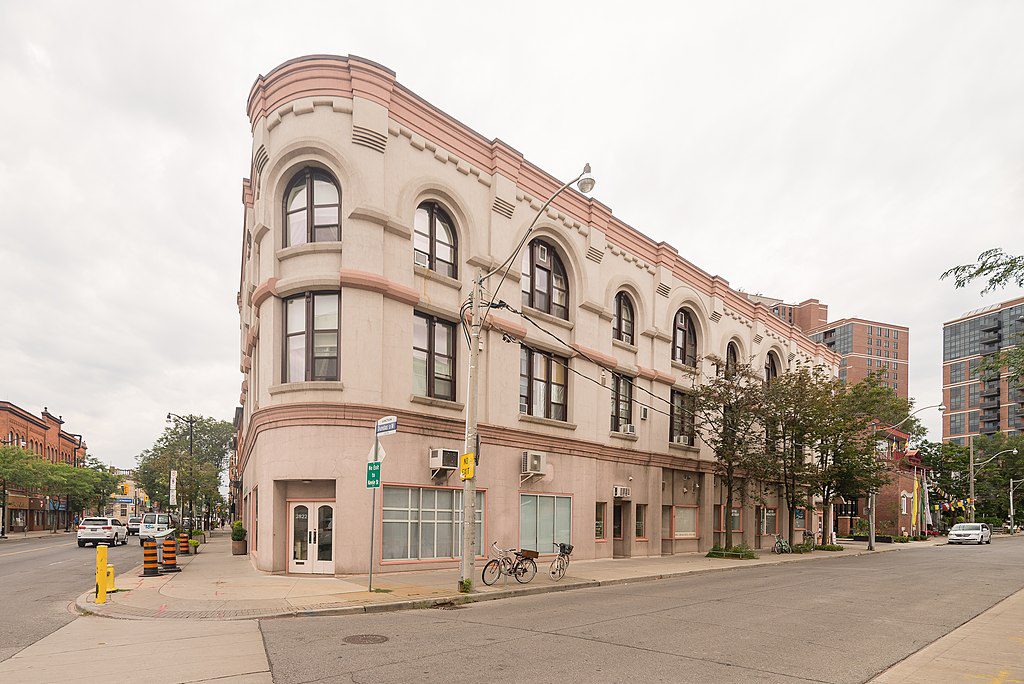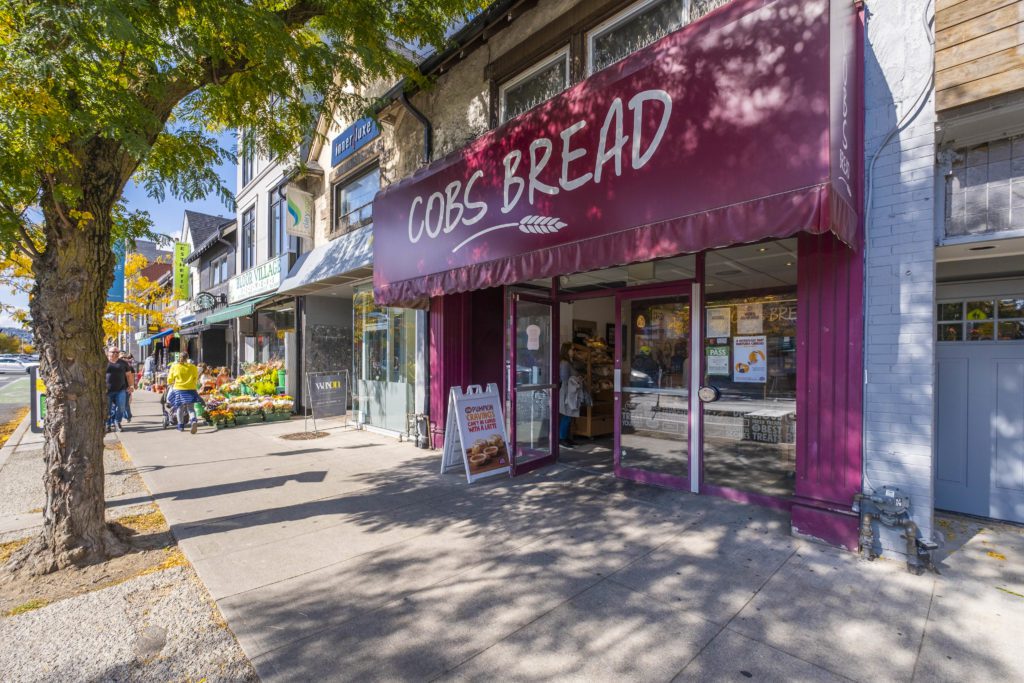All The Reasons to Love Living in The Junction
09/02/24

Nestled in Toronto’s west end, The Junction is a neighbourhood that effortlessly combines its rich historical roots with contemporary urban living. Originally established in 1888 as a quiet railway hub, it has grown into a vibrant community known for its eclectic architecture, lively streets, and strong sense of togetherness. Whether you’re attracted to its artistic atmosphere, historic homes, or dynamic local culture, The Junction offers a unique lifestyle that continues to draw a diverse and engaged population.
- Geography and Boundaries
- A Dynamic History
- Demographics
- Economy and Employment in The Junction
- Education in The Junction
- Recreation in The Junction
- Culture and Community in The Junction
- Transportation and Accessibility in The Junction
- Shopping and Dining in The Junction
- Green Spaces and Environmental Initiatives in The Junction
- Historical Buildings and Sites in The Junction
- The Junction Neighbourhood: Housing Styles, Residential Mix, and Demographics
- Are you ready to love living in The Junction?
Geography and Boundaries
Official Boundaries vs. Popular Definition
The Junction’s geography is defined both by its official and more commonly recognized boundaries. Officially, the City of Toronto maps out The Junction over a broader area, extending north and south beyond what most locals consider its core. However, residents and realtors typically define The Junction more narrowly, focusing on the area north of Annette Street, south of the railway tracks, bordered by Runnymede Road to the west and the railway lines to the east.
Key Streets and Landmarks
At the heart of The Junction lies the bustling intersection of Dundas Street West and Keele Street. This area, along with streets like Annette Street, St. Clair Avenue West, and Runnymede Road, forms the backbone of the neighbourhood.
Notable Landmarks:
- West Toronto Diamond: The historic junction of four railway lines that gave the neighbourhood its name.
- The Stockyards: Located in the northeastern quadrant, this area has historical significance and continues to be a point of interest.
- Former Carlton Race Course Site: This area is now roughly bounded by High Park Avenue and Pacific Avenue, between Glenlake Road and Annette Street, and serves as a reminder of the neighbourhood’s early days.
Proximity to High Park and Other Notable Areas
While High Park is not within The Junction’s boundaries, its close proximity adds significant value for residents. This expansive green space is easily accessible and offers a range of recreational opportunities.
Another key feature is the West Toronto Railpath, which opened in 2009. This path provides a direct link for pedestrians and cyclists from The Junction to the Dundas and Lansdowne area, enhancing connectivity and accessibility.
Nearby Neighbourhoods:
- Runnymede-Bloor West Village: Located to the south, this area is just a short distance away and offers additional amenities and charm.
- The area north of St. Clair Avenue West: This neighbourhood is closely associated with The Junction and shares much of its character.
Historical Context
The original boundaries of the City of West Toronto, before its amalgamation with Toronto in 1909, were significantly larger than today’s Junction. They extended north to Rowntree Avenue, east along the Canadian National tracks, south to Bloor Street, and west as far as Jane Street in some areas. These historical boundaries reflect the broader extent of what was once considered part of the area.
The Junction’s geography is deeply influenced by its historical development around railway lines and industry. These elements have shaped its current boundaries and continue to define its layout. The neighbourhood’s proximity to green spaces like High Park, along with its connections to other areas via the West Toronto Railpath, contribute to its appeal and accessibility.
A Dynamic History

Early Settlement and Development
The Junction’s history is one of continuous transformation, evolving from a rural area into a thriving urban neighbourhood. The area began to take shape in the early 19th century when John Scarlett, a significant landowner, established his estate, “Runnymede,” near what is now Dundas Street West and St. John’s Road. The real turning point came in 1884 with the founding of the Village of West Toronto Junction at the intersection of Dundas and Keele Streets. This marked the start of rapid development, driven by its strategic location and growing industrial activity.
Railway Junction Significance
The Junction’s name is no accident—it comes from the convergence of four major railway lines in what was known as the West Toronto Diamond. The arrival of these railways in the 1880s was a game-changer, sparking rapid development and turning the area into a key industrial hub. The Canadian Pacific Railway established major operations here, with rail yards stretching from Keele Street to Scarlett Road. This railway presence attracted a variety of industries, from foundries and mills to furniture assembly and meat processing, cementing The Junction’s role as an industrial powerhouse.
Prohibition Era
In the early 20th century, The Junction became known for its vibrant, albeit rowdy, working-class culture, which led residents to vote for a ban on alcohol sales in 1904. This prohibition lasted nearly a century, significantly shaping the neighbourhood’s character by slowing its development and giving it a more subdued atmosphere compared to other parts of the city. The ban was finally lifted in 1998, a milestone that sparked The Junction’s revitalization and ushered in the diverse, dynamic community that thrives today.
Demographics
The Junction is home to a diverse and evolving population. As of the 2016 census, the neighbourhood had 14,366 residents, reflecting a 4.5% increase from the previous census. This growth underscores the area’s appeal as a vibrant community that attracts a wide range of residents.
The age distribution in The Junction is fairly balanced, with a significant proportion of working-age adults. Nearly half of the population (45%) falls within the 25-54 age range, making it a popular neighbourhood for professionals and young families. The breakdown is as follows:
- 0-14 years: 15%
- 15-24 years: 12%
- 25-54 years: 45%
- 55-64 years: 12%
- 65+ years: 16%
Diversity is a defining feature of The Junction, though it is slightly less ethnically diverse than Toronto as a whole. Visible minorities make up 29% of the population, compared to 49% citywide. The neighbourhood is a cultural mosaic, with residents representing 135 different ethnic origins. A significant portion of the population, 34%, identifies as first-generation immigrants, with another 31% as second-generation, contributing to the rich cultural fabric of the community.
Household composition in The Junction varies, reflecting the neighbourhood’s broad appeal. Families with children make up 36% of households, couples without children account for 22%, and one-person households represent 33%. With an average household size of 2.33 persons, The Junction is a place where different lifestyles coexist harmoniously. The neighbourhood’s dynamic nature is evident in its mobility, with 37% of households having moved within the past five years, and 12% within the last year.
Economy and Employment in The Junction
The Junction’s economy has undergone a significant transformation, evolving from an industrial powerhouse into a diverse and thriving local economy. Historically, the neighbourhood was a centre of industrial activity, driven by its strategic railway connections. Factories, stockyards, and manufacturing plants once dominated the landscape, creating a bustling hub of economic activity.
Historical Transition
As industrial activity declined in the mid-20th century, The Junction faced economic challenges, with many factories closing down. However, the neighbourhood began to experience a revitalization in the late 1990s, particularly after the lifting of the long-standing alcohol prohibition in 1998. This period marked the beginning of The Junction’s resurgence as a vibrant community.
Current Economic Landscape
Today, The Junction is characterized by a diverse local economy that includes independent businesses, creative enterprises, and a flourishing food and beverage scene:
- Retail and Service Sector: The Junction is home to a wide range of small, independent businesses along Dundas Street West, offering a variety of goods and services that cater to the community’s needs.
- Food and Beverage Industry: The neighbourhood has become a culinary destination, with artisanal cafes, trendy restaurants, and specialty food producers drawing both locals and visitors from across Toronto.
- Creative Industries: The Junction has attracted a growing number of creative professionals, including designers, artists, and tech startups, contributing to the area’s dynamic and forward-thinking vibe.
Employment Statistics
As of 2016, The Junction has a healthy labour market:
- Labour Force Participation Rate: 74.0%
- Employment Rate: 70.0%
- Unemployment Rate: 4.0%
These figures reflect a community that is actively engaged in work, with a relatively low unemployment rate.
Commuting Patterns
While The Junction offers various local employment opportunities, many residents commute to work outside the neighbourhood. Public transit is a popular choice, with 44% of commuters relying on it for their daily journeys, ensuring that The Junction is well-connected to the rest of Toronto.
Major Industries
Key sectors driving the local economy include:
- Manufacturing: 19.3% of jobs
- Wholesale and Retail Trade: 16.3% of jobs
- Professional, Scientific and Technical Services: 11.0% of jobs
These industries provide a range of employment opportunities, catering to different skill sets and career paths.
Economic Challenges and Opportunities
The Junction continues to face both challenges and opportunities as it evolves:
- Gentrification: While gentrification has brought economic growth, it has also raised concerns about affordability, particularly for long-time residents and small businesses.
- Employment Growth: The Junction is part of the Junction-Weston-Dupont Area of Employment, which has seen significant job growth, especially in the food and beverage industry. This growth strengthens the local economy and provides new opportunities for business development.
- Small Business Hub: The neighbourhood’s supportive environment and vibrant community make it an attractive location for startups and entrepreneurs, particularly in creative and tech-related fields.
Education in The Junction

The Junction stands out as a family-friendly neighbourhood, offering a broad array of educational opportunities that cater to the diverse needs of its residents. The area is served by multiple school boards and provides access to both traditional and alternative learning environments.
School Boards
Residents of The Junction are served by four distinct school boards, each offering different educational approaches:
- Toronto District School Board (TDSB): The largest board in the area, providing English, secular education.
- Toronto Catholic District School Board (TCDSB): Offers English-language Catholic education with a strong faith-based curriculum.
- Conseil scolaire Viamonde: Provides French, secular education, catering to the Francophone community.
- Conseil scolaire de district catholique Centre-Sud: Offers French-language Catholic education, blending language and faith in their curriculum.
Notable Schools
The Junction is home to several notable schools, each with a unique history and educational offering:
- Annette Street Public School (265 Annette Street): A cornerstone of the community since 1886, this school shares its facilities with High Park Alternative School, The Junction Daycare, and the Toronto Parks and Recreation Department.
- Indian Road Crescent Junior Public School (285 Indian Road Crescent): Serving Junior Kindergarten through Grade 6, this school fosters a nurturing environment for its students and also hosts the Holland-Bloorview Kids Rehabilitation daycare.
- St. Cecilia Catholic School (355 Annette Street): Established in 1914, St. Cecilia has been a pillar of Catholic education in The Junction for over a century, with several expansions to accommodate the growing community.
Special Programs
The schools in The Junction offer a variety of special programs designed to meet the diverse needs of their students:
- Special Education: Tailored support for students with unique learning needs.
- French Immersion: Bilingual education that immerses students in the French language.
- International Baccalaureate (IB): A rigorous, internationally recognized curriculum preparing students for global citizenship.
- Montessori: An educational approach focused on hands-on, self-directed learning.
- Advanced Placement (AP): College-level courses offered to high school students, providing opportunities for advanced academic challenges.
Educational Attainment
The Junction is home to a highly educated population, reflecting the community’s emphasis on learning. As of the 2016 census, educational attainment among residents aged 25-64 was as follows:
- No certificate, diploma or degree: 8%
- Secondary (high) school diploma: 18%
- Apprenticeship or trades certificate/diploma: 4%
- College, CEGEP, or other non-university certificate or diploma: 18%
- University certificate or diploma below bachelor level: 2%
- Bachelor’s degree: 32%
- University certificate, diploma or degree above bachelor level: 18%
With half of the residents holding a bachelor’s degree or higher, The Junction’s population is well-educated, contributing to the neighbourhood’s vibrant, informed, and engaged community.
Historical Note
Education in The Junction is steeped in history, with many schools playing a significant role in shaping the community’s identity. One such story is that of the former St. Clair Avenue Public School, constructed in 1912 near Britannia Avenue. Although it was demolished in the early 1990s to make way for townhouses, the site remains a symbol of the neighbourhood’s evolving landscape, where history and progress intertwine.
Recreation in The Junction
The Junction is a neighbourhood that offers a variety of recreational opportunities, making it a vibrant and engaging place for residents of all ages. Whether you’re a cyclist, a park enthusiast, or someone who enjoys community events, The Junction has something to offer.
West Toronto Railpath

A standout feature of The Junction is the West Toronto Railpath, a popular multi-use path that opened in 2009. This scenic route provides pedestrians and cyclists with a direct link from The Junction to the Dundas and Lansdowne area. More than just a pathway, the Railpath is a space where art, nature, and community converge. Plans to extend the path further south to Liberty Village promise even more opportunities for exploration and connectivity within the city.
Community Events
The Junction is known for its lively community events, which bring residents together and attract visitors from across Toronto:
- The Junction Summer Solstice Festival: Held every June, this festival celebrates the longest day of the year with music, art, food, and a vibrant street fair atmosphere along Dundas Street West.
- Contact Photography Festival: Each May, The Junction participates in this citywide event, showcasing the work of local and international photographers. The neighbourhood’s galleries, shops, and outdoor spaces serve as canvases for striking visual narratives.
These events highlight the creativity, diversity, and strong community spirit that define The Junction.
Parks and Recreational Facilities
Green spaces are integral to The Junction’s appeal, offering residents places to relax, play, and connect with nature. The neighbourhood is home to several parks, each with its own unique character, and a total of 27 recreational facilities spread across these parks. Whether you’re looking for a quiet spot to unwind, a playground for the kids, or a place to exercise, The Junction’s parks have something for everyone.
Recreational Facilities in Neighbourhood Parks
- 12 Playgrounds: Safe and fun spaces for children to explore.
- 1 Dog Park: A dedicated area for dogs to run and socialize.
- 1 Arena & 1 Rink: Facilities for hockey or skating, keeping the community active year-round.
- 2 Tennis Courts & 2 Basketball Courts: Perfect for matches or pickup games.
- 1 Ball Diamond & 1 Sports Field: Ideal for organized sports or casual games.
- 4 Splash Pads: A refreshing way for kids to cool down during the summer.
- 2 Outdoor Games Facilities: Spaces for activities like bocce or table tennis.
With an average of two facilities per park, The Junction’s green spaces are well-equipped to meet the recreational needs of the community.
Accessibility
Accessibility is a key feature of The Junction, ensuring that residents and visitors can easily reach the area’s recreational spots. The neighbourhood is served by 109 transit stops, making it convenient to access parks, events, and other amenities without needing a car. Additionally, nearby rail stations, particularly along Dundas Street, provide easy access for those commuting to or from The Junction.
Culture and Community in The Junction

The Junction is celebrated for its vibrant cultural scene and strong sense of community, offering a rich tapestry of events, artistic expressions, and local initiatives that reflect the neighbourhood’s unique character.
Annual Events
The Junction hosts a variety of annual events that showcase its creativity and community spirit:
- Taste of the Junction: Held every September, this culinary celebration brings together local businesses to highlight the neighbourhood’s diverse food scene. Organized by the Junction Business Improvement Area (BIA), the event features restaurants and food vendors offering a range of flavours that represent the multicultural fabric of the community.
- AR Laneway Project: An innovative fusion of art and technology, this project features the “Rhapsody in Gold” mural at 2896 Dundas St W. Visitors can experience the mural through augmented reality, making it an interactive and immersive addition to The Junction’s public art offerings.
- Butterfly Garden Walking Tours: These tours promote local biodiversity and environmental awareness, guiding participants through community gardens designed to support local wildlife, including butterflies.
- Winter Window Wonderland: Each holiday season, The Junction transforms into a festive wonderland as local storefronts are adorned with creative and interactive displays, adding a touch of seasonal charm to the neighbourhood.
Arts and Culture
The Junction boasts a thriving arts scene, with numerous galleries and studios contributing to its creative atmosphere. Public art installations are scattered throughout the neighbourhood, offering residents and visitors a chance to engage with art in their everyday surroundings. The Junction’s participation in city-wide events like the Contact Photography Festival further cements its reputation as a hub for artistic expression, drawing both local and international talent.
Community Organizations
At the heart of The Junction’s cultural and community life is the Junction Business Improvement Area (BIA). This organization plays a crucial role in organizing events, supporting local businesses, and fostering a sense of community among residents. The BIA’s efforts are instrumental in maintaining The Junction’s unique character and ensuring that it remains a vibrant, engaging place to live and visit. Alongside the BIA, various community groups focus on environmental sustainability, local history, and neighbourhood improvement, helping The Junction thrive as a dynamic and forward-thinking community.
Diversity and Inclusion
The Junction is home to a diverse population, with residents from a wide range of ethnic backgrounds. This diversity enriches the neighbourhood, contributing to its cultural vibrancy and dynamic community life. Community events and initiatives often celebrate this multiculturalism, promoting inclusivity and fostering a welcoming environment for everyone.
Local Businesses
The Junction is known for its eclectic mix of independent shops, cafes, and restaurants, each contributing to the neighbourhood’s unique character. These businesses are the backbone of the local economy and play an active role in community life, frequently participating in and supporting events that enhance the area’s cultural fabric.
Historical Significance
The Junction’s rich industrial heritage is evident in its architecture and street layouts, which serve as a reminder of the neighbourhood’s past. Ongoing efforts to preserve and celebrate this history ensure that while The Junction continues to evolve, it never loses sight of the legacy that has shaped its identity.
Green Spaces and Recreation
Green spaces and recreational facilities are integral to The Junction’s community engagement. The neighbourhood offers multiple parks and community gardens, where residents can enjoy outdoor activities and connect with nature. Environmental initiatives further encourage a sustainable lifestyle and a strong community bond through shared efforts in maintaining these green spaces.
Transportation and Accessibility in The Junction

The Junction is a neighbourhood that offers excellent transportation options, making it easy for residents to connect with the rest of Toronto. Whether by public transit, bicycle, car, or on foot, getting around The Junction and beyond is convenient and efficient.
Public Transit
The Junction is well-served by public transportation, providing residents with easy access to the entire city. With 109 transit stops throughout the area, the neighbourhood is accessible via several TTC bus routes and streetcar lines. This extensive transit network ensures that daily commutes and trips across Toronto are straightforward for Junction residents.
Rail Stations
For those travelling further afield, The Junction is strategically located near key rail stations. The Dundas West station on the Bloor-Danforth subway line serves the eastern edge of the neighbourhood, offering a quick and direct route to downtown Toronto and other parts of the city. Additionally, the nearby Bloor station provides UP Express and GO Transit services, connecting residents to Pearson Airport and the Greater Toronto Area.
Cycling Infrastructure
Cycling enthusiasts will appreciate The Junction’s growing network of bike-friendly paths. The West Toronto Railpath, opened in 2009, is a dedicated cycling and pedestrian path that offers a direct link from The Junction to the Dundas and Lansdowne area. This scenic route is popular among cyclists for both commuting and leisure, and plans are in place to extend the Railpath further south to Liberty Village, which will enhance cycling connectivity and make the neighbourhood even more accessible by bike.
Walkability
One of The Junction’s most appealing features is its walkability. The neighbourhood is known for its pedestrian-friendly streets, with many local amenities, including shops, cafes, and parks, within easy walking distance. The compact layout and mixed-use development of The Junction contribute to a community where residents can accomplish daily errands, enjoy recreational activities, and socialize with neighbours—all without needing a car.
Major Roads
For those who drive, The Junction offers easy access to major roads that connect to other parts of Toronto. Dundas Street West and Keele Street are the main arterial roads running through the neighbourhood, providing direct routes to key areas of the city. These roads ensure that whether you’re heading downtown or to other parts of the GTA, the commute is manageable.
Proximity to Downtown
The Junction’s location is another major draw for residents, especially those who work in the city centre. The neighbourhood offers relatively quick access to downtown Toronto, making it an attractive option for commuters who want the charm of a quieter residential area without sacrificing proximity to the vibrant core of the city.
Accessibility Features
In line with Toronto’s broader commitment to inclusivity, many of the newer developments and public spaces in The Junction are designed with accessibility in mind. This includes features that accommodate those with mobility challenges, ensuring that all residents can navigate and enjoy the neighbourhood’s amenities comfortably and safely.
Future Transportation Projects
The Junction’s transportation network is not static; ongoing discussions about improving public transit and cycling infrastructure could lead to enhanced connectivity in the future. These potential projects promise to keep The Junction at the forefront of accessible and sustainable urban living.
Shopping and Dining in The Junction

The Junction has grown into a lively area known for its variety of shops, eateries, and local businesses. Stretching along Dundas Street West from Keele Street to Quebec Avenue, this neighbourhood offers a unique shopping and dining experience.
As you walk through The Junction, you’ll find a wide range of storefronts, each with its own character. The area is known for its welcoming atmosphere, where independent coffee shops, boutiques, and other local businesses thrive.
Food lovers have plenty of options in The Junction. The neighbourhood features a diverse culinary scene, including spots like Indie Alehouse for craft beers, Dirty Food Eatery for comfort food, and Bevi Birra for Italian cuisine. Many restaurants participate in Toronto’s CaféTO program, offering outdoor dining during the warmer months.
In addition to its dining options, The Junction is a great place to shop. Stores like Caribou Gifts offer unique items, while Pretty Clean Shop caters to eco-conscious customers. Epic Cycles is popular with cycling enthusiasts, and Ren’s Pets is a go-to for pet owners.
The Junction is also known for blending business with culture. Many local shops double as art galleries or event spaces, offering more than just shopping. The Winter Window Wonderland event, where local businesses create festive window displays, is a good example of this community spirit.
The Junction Business Improvement Area (BIA) plays a key role in supporting local businesses and organizing events. Their work helps keep the neighbourhood clean and welcoming, contributing to the strong sense of community.
As The Junction continues to grow, it balances new developments with its historical roots. New businesses are opening, while long-time establishments remain important parts of the community. This mix ensures there’s always something new to explore, while maintaining the neighbourhood’s familiar and friendly feel.
Green Spaces and Environmental Initiatives in The Junction

The Junction is not only known for its vibrant urban life but also for its strong commitment to green spaces and environmental sustainability. These efforts provide residents with opportunities to connect with nature and promote a healthy, eco-friendly lifestyle within the neighbourhood.
Green Spaces
The Junction boasts a variety of parks and green spaces that serve as community hubs for relaxation, recreation, and outdoor activities. Each park in the neighbourhood offers something unique, from playgrounds and sports facilities to quiet spots for unwinding. These green spaces are essential to the quality of life in The Junction, providing residents with easy access to nature amidst the urban environment.
Environmental Initiatives
The Junction is also dedicated to environmental sustainability through various community-led initiatives. One of the standout projects is the Butterfly Garden initiative, which involves cultivating gardens designed to support local biodiversity, particularly pollinators like butterflies and bees. These gardens not only enhance the neighbourhood’s beauty but also contribute to the ecological health of the area.
Residents and visitors can participate in guided Butterfly Garden walking tours, where they learn about native plants, the importance of urban biodiversity, and how these efforts contribute to a sustainable environment. This initiative reflects The Junction’s commitment to preserving its natural surroundings and fostering a sense of environmental stewardship among the community.
Eco-Friendly Businesses
The Junction’s commitment to sustainability extends to its local businesses. Many shops and restaurants in the area have adopted eco-friendly practices, such as reducing plastic use and sourcing sustainable products. For example, Pretty Clean Shop offers environmentally friendly household products, aligning with the neighbourhood’s green values.
Community Engagement
Environmental initiatives in The Junction are often driven by community involvement. Local groups regularly organize events like neighbourhood clean-ups, tree planting days, and workshops on sustainable living. These activities not only improve the environment but also strengthen the community’s bond through shared efforts to maintain and enhance the neighbourhood’s green spaces.
Historical Buildings and Sites in The Junction
The Junction is steeped in history, with numerous buildings and sites that reflect its rich industrial and cultural past. These landmarks contribute to the neighbourhood’s unique character and serve as enduring reminders of The Junction’s significant role in Toronto’s development.

Campbell Block
Located at the intersection of Dundas Street West and Pacific Avenue, the Campbell Block is one of The Junction’s most notable historical buildings. Constructed in the 1890s, this commercial building exemplifies the architectural style of that era and has been designated a heritage site. The Campbell Block once housed the Junction College of Music, highlighting its historical importance as a cultural hub.
West Toronto Station
Although the original building no longer stands, the West Toronto Station was a key railway station owned by the Canadian Pacific Railway (CPR). This station played a crucial role in establishing The Junction as a major railway hub in the late 19th and early 20th centuries. Its legacy is a vital part of the neighbourhood’s identity, reflecting its industrial heritage.
Annette Street Public School
Annette Street Public School, located at 265 Annette Street, is one of The Junction’s oldest educational institutions. The original building was constructed in 1886, with expansions added in later years. The school remains a cornerstone of the community, not only as an educational facility but also as a historical landmark that has witnessed generations of local residents.
St. Cecilia Catholic School
Established in 1914, St. Cecilia Catholic School at 355 Annette Street has served the local community for over a century. The school has undergone several expansions, reflecting the growth of the neighbourhood. Its long history as an educational institution makes it an integral part of The Junction’s cultural and historical fabric.
Former Heintzman Piano Factory
While the original Heintzman Piano Factory building no longer exists, its site remains historically significant. The factory was renowned for producing high-quality pianos that were sold across Canada and internationally. Today, the site has been redeveloped into condominiums, but the legacy of the Heintzman brand continues to be associated with The Junction’s industrial past.
Victorian Homes
The Junction is home to many well-preserved Victorian-era houses, which line its streets and add to the neighbourhood’s historical charm. These homes, characterized by their red-brick facades and intricate architectural details, offer a glimpse into the area’s development during the late 19th century. They are a key part of The Junction’s residential appeal and historical identity.
West Toronto Railroad Allegory Mural
This mural commemorates The Junction’s significant railway history, particularly the Canadian Pacific Railway’s West Toronto Junction. The mural serves as a visual tribute to the neighbourhood’s industrial roots and the central role it played in Toronto’s railway development.
Former Site of Carleton Race Course
The area along Annette Street and Pacific Avenue was once home to the Carleton Race Course, which hosted the first Queen’s Plate horse race in the 19th century. Although the racecourse no longer exists, its history is an important part of The Junction’s heritage, marking the neighbourhood’s early connection to Toronto’s social and recreational life.
Former Junction College of Music
Once housed in the Campbell Block at Keele and Dundas Streets, the Junction College of Music was a significant cultural institution in the early 20th century. It played a key role in nurturing local talent and contributed to The Junction’s reputation as a centre for arts and culture.
The Junction Neighbourhood: Housing Styles, Residential Mix, and Demographics
The Junction is a diverse and historically rich neighbourhood that offers a variety of housing styles and a dynamic residential mix, reflecting its evolution over time. The area’s demographic profile further adds to its vibrant community atmosphere.
Housing Styles

The Junction’s architectural landscape is a blend of historical and contemporary designs, showcasing its growth from a 19th-century railway town to a modern urban neighbourhood.
- Victorian Era Homes: The Junction is known for its Victorian-era houses, distinguished by their red-brick facades, sharply gabled roofs, and ornate details. These homes are a key feature of the area’s older streets, adding to the neighbourhood’s historical charm.
- Edwardian Era Homes: Built between 1901 and 1914, Edwardian homes in The Junction are characterized by their wider, boxier structures and substantial front porches. These homes represent the transition from Victorian architecture to more modern styles and are commonly found throughout the neighbourhood.
- Tudor Revival Homes: These homes, with their decorative half-timbering, dark wood accents, and steeply pitched roofs, bring a distinct flair to The Junction. While more commonly associated with upper-class areas, they contribute to the architectural diversity of The Junction.
Residential Mix
The Junction offers a variety of housing types that cater to different needs and preferences, making it an appealing place for a diverse range of residents.
- Single-Family Homes: These traditional homes dominate the residential areas, especially north of Dundas Street West, offering spacious living environments ideal for families.
- Semi-Detached Houses: A common sight throughout The Junction, semi-detached houses offer a balance of space and affordability, making them a popular choice for many residents.
- Row Houses: Found in various parts of the neighbourhood, row houses provide higher-density living while maintaining a strong sense of community.
- Low-Rise Apartments and Condos: Scattered along major streets and increasingly along Dundas Street West, low-rise apartment buildings and newer condominium developments offer modern living options, particularly attractive to young professionals and smaller households.
Recent Developments
In recent years, The Junction has seen an increase in mid-rise condominium projects, particularly along the Dundas Street West corridor. These developments are part of a broader trend toward urban densification, catering to the growing demand for housing in this vibrant neighbourhood. The adaptive reuse of former industrial buildings into loft-style residences has also preserved The Junction’s historical essence while providing contemporary living spaces.
Demographics
The Junction’s population is diverse and continues to evolve, contributing to the neighbourhood’s dynamic character. As of the 2016 census, the area had a population of 14,366, reflecting a steady growth. The demographic breakdown shows a balanced mix of age groups, with a strong representation of working-age adults:
- 0-14 years: 15%
- 15-24 years: 12%
- 25-54 years: 45%
- 55-64 years: 12%
- 65+ years: 16%
The Junction is slightly less ethnically diverse than the city as a whole, with visible minorities making up 29% of the population. However, the neighbourhood is home to residents from 135 different ethnic origins, creating a culturally rich and inclusive community.
Household composition in The Junction is varied, with 36% of households comprising families with children, 22% being couples without children, and 33% being one-person households. The average household size is 2.33 persons, reflecting the neighbourhood’s ability to accommodate a range of lifestyles.
Gentrification and its Impact

Kilburn Hall built in 1891 designated heritage by City of Toronto via Wikimedia
Over the past two decades, The Junction has undergone significant gentrification, attracting a more affluent demographic and leading to rising property values. While this has brought positive changes, such as increased investment and the revitalization of local businesses, it has also raised concerns about affordability and the displacement of long-time residents. Balancing the benefits of gentrification with the need to maintain the neighbourhood’s diverse and inclusive character remains an ongoing challenge.
Are you ready to love living in The Junction?
Whether you’re drawn to The Junction’s rich history, diverse community, or vibrant housing market, it’s clear that this neighbourhood has something special to offer. If you’re considering making The Junction your home, the Smith Proulx team is here to help. With our in-depth knowledge of the area and commitment to finding the perfect home for our clients, we’re ready to guide you through every step of the buying process.
Contact us today to explore your options and discover how we can help you find your ideal home in The Junction.
Ready To Call The Junction "Home?"
With a neighbourhood as diverse as The Junction, we can find you your perfect fit! Let's talk about it.



